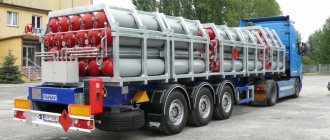Refrigerated transportation today is a very popular service, but before talking about its features, you need to decide what it is in principle. The variety of products transported by road is incredibly large.
And not all cargo requires the same storage and transportation conditions, which must be taken into account when selecting a vehicle. A huge number of goods are classified as perishable, otherwise, with a short shelf life.
To transport them, it is necessary to create appropriate conditions, primarily in terms of low temperature conditions. This problem is solved through refrigerators equipped with a specialized temperature and humidity control system, as well as refrigeration units.
Transportation by refrigerators in our country is a service that is in demand all year round. You can rent such equipment from specialized companies.
Classification of special vehicles
Refrigerated transportation, as mentioned earlier, is the transportation of perishable goods using vehicles equipped with a special body in which a given temperature regime is maintained using refrigeration equipment. This type of delivery of goods is ideal for long journeys over long distances, since there is no need to use additional special equipment for cooling or freezing, for example, food.
It is not difficult to select the optimal vehicle for each specific category of cargo. To do this, it is enough to know the current classification of refrigerated vehicles, which implies the following gradation of vehicles.
Trucks of various types are usually divided into groups according to weight category. According to this parameter, vehicles with a maximum load capacity of up to:
- 3 tons – low;
- 5 tons – average;
- 20 tons is high.
In addition, refrigerated trucks are distinguished by the temperature regime maintained in the body:
- 0 / +12 degrees Celsius – class “A”;
- -10 / +12 degrees Celsius – class “B”;
- -20 / +12 degrees Celsius – class “C”;
- -20 / +2 degrees Celsius – class “D”;
- -10 degrees Celsius and below – class “E”;
- -20 degrees Celsius and below – class “F”.
In this case, it can be stated that in the back of class “E” and “D” vehicles, light freezing of cargo is possible, and the lowest temperature indicators can be maintained in a class “F” refrigerator.
Reefer container
A universal refrigerated container of 20 or 40 feet can be transported by road using a container truck. Also, a refrigerated container can be loaded onto rail or sea transport. Refrigerators or vans with special isothermal bodies (isothermal vans) capable of providing the required temperature conditions during the transportation of perishable goods. A refrigerated container is a sea container with a special thermal insulation body that allows you to maintain a certain temperature inside for a long time (about the same as a regular thermos). A reefer container equipped with a refrigeration unit is used for transporting temperature-sensitive goods. Most often it has an aluminum body and polyurethane foam insulation. Refrigerated containers have a built-in refrigeration and heating unit (RHU), so they require connection to a power supply. In a warehouse or on a ship, these will be stationary points for connection; when transporting on a trailer on roads, mounted diesel generators connected to containers can be used.
Documents for transportation of temperature-sensitive cargo
The shipper is obliged to provide the carrier with the necessary accompanying documents for the shipment. In the transport bill of lading (TN) and bill of lading (BWB), note the temperature regime, the maximum duration of transportation of perishable cargo and other special conditions. Documentary information about the conditions under which perishable cargo must be transported will help the carrier to properly ensure its safety.
To transport perishable cargo, you will need accompanying documents, among which the driver must have:
- Consignment note or waybill;
- Waybill;
- A quality certificate containing the main characteristics of the product and confirming its compliance with norms and standards;
- Veterinary certificate - for products of animal origin;
- Sanitary and hygienic certificate confirming the hygienic safety of the product;
- Quarantine (or phytosanitary) certificate for products of plant origin, confirming the absence of diseases;
- Standard documents for a car - technical passport, inspection certificate, insurance policy;
- ATP Certificate (approval for transportation of perishable goods);
- Checklist for checking the temperature of the cargo and the air in the car body at the time of loading.
In other words, all documents that confirm the quality and safety of the products that the driver is carrying in the truck. You also need to have a sanitary-epidemiological conclusion in the form of certified copies. Depending on the type of cargo, a veterinary certificate may be required. The shipper transfers the cargo to the carrier in a clean, dry, durable container that meets sanitary and hygienic standards and is not subject to corrosion or other damage. If there is such a possibility, the container must be sealed; if not, then the vehicle must be sealed.
Motor transport companies and enterprises that are involved in the transportation of perishable goods are required to comply with the requirements of SanPiN. You also need to comply with the requirements that contain the rules for transporting perishable goods by road and other regulatory and technical documents of the professional industry. Personnel involved in the transportation of perishable goods - drivers, forwarders and loaders - must undergo an annual medical examination, maintain personal hygiene, have a medical record and clean overalls.
Advantageous offer for the transportation of temperature-sensitive cargo in refrigerators
Prices for transport services in our company are the most reasonable among similar auto companies due to the competent work of a staff of highly qualified specialists. Our managers will calculate and agree on optimal transportation schemes for your products in the shortest possible time and at the lowest cost. The modern fleet of special cargo vehicles of the transport company TransAvtoTsisterna allows us to significantly increase the productivity of our logistics service. That is why the tariffs for transportation in our auto company are the most favorable and are available to companies of different levels.
To transport temperature cargo you can: CALL US ↔ ORDER A CALL LEAVE A REQUEST
Rules for transportation by refrigerated trucks
According to international standards, refrigerated trucks must undergo a full technical inspection and sanitary treatment of the cargo compartment before each trip. After these activities, the driver receives the appropriate documents (including a sanitary passport) confirming the safe operation of the truck.
In addition, this transport is equipped with a modern GPS tracking system, which provides the ability to control the movement of the vehicle with cargo. And the drivers themselves regularly undergo medical examination, which is mandatory on the day of departure on the route.
Packaging of perishable goods
Containers and packaging are important for ensuring the safety of perishable goods. As a rule, perishable food products are transported in containers. It must be durable, in good working order, dry and clean, without foreign odors.
Perishable products are transported in wooden, cardboard and plastic boxes; cardboard boxes; barrels and flasks; bags.
Many perishable products are pre-packaged in bags, placed in metal or glass jars, and bottled before being placed in containers.
The carrier can check the quality of perishable goods and the condition of their containers. The opening of the cargo and its subsequent packaging after inspection is carried out by the shipper.
Transportation Features
Compliance with safety precautions and sanitary standards in force in the countries through which the refrigerator is moving are mandatory conditions for cargo transportation of this type.
In addition, proper placement of cargo in the back of a vehicle is of great importance. This means that products and goods transported in the same cargo compartment must be absolutely compatible with each other. As an example, we can mention the prohibition of transporting meat and milk in a single compartment of a refrigerator.
Main mistakes leading to unsafe cargo
Often, quick and poor-quality loading and placement of goods in the back of a vehicle leads to its unsafety. For the normal organization of the transportation process, the rules must be strictly followed.
The cargo may be damaged as a result of:
- loading of incompatible goods (from different categories);
- improper placement of pallets;
- temperature violation;
- receiving goods in broken containers;
- malfunctions of loading mechanisms (if loading is mechanical);
- violation of the loading process.
Transportation requirements
To carry out refrigerated transportation, vehicles with special characteristics are required, which, moreover, meet regulated requirements. In addition to the mandatory presence of a sanitary passport, the car must have refrigeration equipment that provides heating and cooling of the cargo, respectively, in winter and summer.
Before sending a refrigerator, the temperature in its body is measured, and this data is entered into the accompanying documents. Containers that should not be damaged are also subject to inspection. The documentation also indicates the period of transportability of the cargo and the numbers of seals on the container, if any are used for security purposes.
The following cargoes are subject to transportation by refrigerated trucks:
- fish and meat;
- caviar and eggs;
- berries, fruits and vegetables;
- milk and dairy products;
- butter and cheese;
- serums and vaccines;
- medicines, organs for transplantation and donated blood;
- all kinds of frozen food products.
Among other things, live plants, seeds, seedlings, tubers, flowers, etc. are delivered using refrigerated trucks.
The temperature classification adopted in the Russian Federation and the EU provides for the following categories of products.
- -18 °C – deep frozen;
- -17 / -7 °C – frozen;
- -6 / +4 °C – chilled;
- natural indicators of temperature and humidity - fresh;
- 2-3 °C above ambient temperature - heated.
In conclusion, we note that the rules and regulations for refrigerated cargo transportation are almost identical for sea, road, air and rail transport.
Features of transporting frozen fish
Products must not be transported in refrigerators where the temperature is less than -18 °C. Before the flight, the car is disinfected and cooled. They load goods in small quantities in boxes and pallets quickly to prevent defrosting. Conditions:
- Testing of climate control equipment before departure. If a car breaks down, the batch is immediately reloaded or delivered to a warehouse with freezers.
- Dense placement - in case of force majeure it will melt more slowly.
- Placing on pallets will prevent fish from sticking to the floor of the chamber; air will circulate freely.
- Temperature conditions for different types of products - chilled and frozen units cannot be placed together.
- Machine load level. Depends on the cargo preservation technology: fast, dry ice, natural.
Unloading is carried out at the recipient's warehouse, immediately transferring the fish to chambers with low temperatures. If the shipment is moving across the Russian Federation, a certified logistician is not required to prepare additional documentation; accompanying papers for the cargo will be required. Delivery within the customs union requires veterinary certificates.
Cost of refrigerated transportation
| Loading point | Unloading point | Refrigerator 82 m³ / 20 t |
| Chelyabinsk | Irkutsk | 220 000 |
| Novosibirsk | 115000 | |
| Omsk | 70000 | |
| Krasnoyarsk | 160 000 | |
| Krasnodar | 80 000 | |
| Vladivostok | 450 000 | |
| Saint Petersburg | 75 000 | |
| Chita | 330 000 | |
| Abakan | 180 000 | |
| Krasnokamensk (Trans-Baikal Territory) | 380 000 | |
| Kazan | ||
| Tyumen | 35 000 | |
| Permian | ||
| Magnitogorsk | ||
| Ust-Kut | ||
| Makhachkala | 130 000 | |
| Grozny | 130 000 | |
| Simferopol | 145 000 | |
| Sochi | 145 000 | |
| Murmansk | 180 000 | |
| Kovdor | 160 000 | |
| Magnitogorsk | Chelyabinsk | |
| Bely Yar | ||
| Ekaterinburg | ||
| Saint Petersburg | Chelyabinsk | 140 000 |
| Ekaterinburg | 135 000 | |
| Tyumen | 140 000 | |
| Permian | 125 000 | |
| Ekaterinburg | Chelyabinsk | 18 000 |
| Saint Petersburg | 75 000 | |
| Tyumen | ||
| Abakan | 180 000 | |
| Krasnodar | 80 000 | |
| Krasnoyarsk | 160 000 | |
| Novosibirsk | ||
| Krasnodar | Chelyabinsk | 135000 |
| Magnitogorsk | 130 000 | |
| Ekaterinburg | 140 000 | |
| Prices are based on a full truck load. Prices for groupage cargo will vary depending on the weight and volume of goods transported. | ||
Features of the use of sea transport
Perishable goods during shipment by sea are transported either in refrigerated containers or on refrigerated ships. Refrigerated containers are made of stainless food steel. They are charged with environmentally friendly freon and maintain a constant temperature using integrated refrigeration equipment. Reefer containers have a high degree of sealing and low energy consumption. Modern models are equipped with self-diagnosis systems and a friendly interface.
The reefer vessel is equipped with a specialized refrigeration system. Refrigerated vessels are divided into five types:
- low-temperature for delivery of refrigerated cargo;
- high-temperature for transporting frozen products;
- universal;
- fruit carriers – vessels with enhanced ventilation;
- Refrigerated fishing vessels perform the functions of harvesting, freezing and transportation.
The holds are thermally insulated and equipped with a ventilation system. Sea freight transportation is characterized by large volumes, low costs, low risks, and the possibility of organizing inexpensive intercontinental transportation. The disadvantages are low speed and dependence on navigation conditions.
To organize the transportation of goods with limited storage time, you can use any type of transport: air or sea, rail or road. Mixed transportation is also allowed when justified.
What is temperature controlled transportation?
This is a type of delivery where goods are transported over long distances while maintaining the recommended temperature. Instead of conventional trucks, equipped vehicles are used. The goal is to create a constant temperature in the body, eliminate sudden changes, and maintain the required humidity. The result is that perishable products do not lose their presentation or beneficial properties. Retain freshness and remain safe for the consumer. Fish, eggs, fruits, medicines, milk, cosmetics, frozen semi-finished products - and these are not all product categories that require special transportation.
A caveat is that only a reputable logistics company can carry out high-quality delivery. Why? It has a fleet of special vehicles (multi-section refrigerators and vans). Experienced drivers strictly follow the rules, which eliminates the risk of product damage. Only if these requirements are met is it possible to transport pharmaceutical products, as well as cosmetics. Food products, alcohol, planting material - employees strictly follow the instructions specified in the documents. They prepare the body: cool or warm it up in advance, thoroughly disinfect it. Make sure there are no foreign odors.
Drinks, canned food and confectionery
Alcohol is delivered at the temperature indicated on the manufacturer's packaging. Beer is transported at temperatures up to +12 C, juices – +15 C. Mineral water is packed in boxes, the permissible temperature is from +2 to +4 C.
Various canned goods (from meat to vegetables) are transported in the temperature range from 0 to +15 C.
Confectionery products can be delivered frozen at – 18 C. These are cakes, dough, margarine, yeast. For baked goods (cakes, rolls with cream) the permissible temperature is up to +6 C. Bread, chocolate, rolls and cookies up to +15 C.
Also, special transportation conditions require planting material - flowers in pots, cut specimens, seedlings of trees and shrubs, soil.
Solving complex problems
When organizing complex schemes, the rules for the transportation of perishable goods are applied separately for each type of transport. You can find out more information in regulatory industry documents. Calculation of combined deliveries is carried out taking into account the shelf life of each product item and their compatibility.
Emergency situations should be resolved as quickly as possible to prevent damage.
For this reason, special attention should be paid to the technical condition of rolling stock and refrigerated equipment. Sealing and other special measures prevent theft.
Natural loss is calculated according to current standards. So, when transported in an insulated car body, losses can amount to a distance of 2 thousand km:
- apples – 4.2%;
- pears – 3.8%;
- plums – 6.8%.
For better preservation, perishable products are transported in a specially prepared environment, which consists of 3–6% oxygen and 94–97% inert gases.
Selecting the optimal delivery option
The use of automobiles is economically feasible over relatively short distances. They are convenient when organizing delivery to several addresses. To successfully solve certain problems, it is worth considering other types of transport:
- Prompt delivery of blood and other medical supplies is carried out using aviation.
- River and sea vessels are suitable for handling large quantities of goods.
- Transportation of perishable goods by rail is carried out strictly according to schedule.
Each method has certain advantages and disadvantages. The slowness of sea transport should be taken into account when calculating the route. However, it is precisely this that has to be used for long-distance intercontinental movement of products with a relatively low unit cost per unit weight. Railroad technologies are cheaper than road technologies, but it is not always possible to organize delivery to the desired address without overloading.
Sanitary standards
Each vehicle delivering food must receive a sanitary passport. This is a mandatory requirement. The paper is issued for a period of six months for the delivery of non-perishable products and for 3 months for the transportation of perishable goods. The document contains information about the latest sanitary treatments of the body.
Purpose of the car
The main condition is that you cannot use a truck that previously delivered harmful and odorous substances to deliver food. These include gasoline, kerosene and toxic substances. A strong odor can be absorbed into the food, which is unacceptable. Toxic substances are very persistent, so they are difficult to wash off.
According to the requirements of SanPiN, for some types of products you should use a special vehicle that has the appropriate markings. These types include: dairy products, meat, bread, fish and sausage.
The covering of the inside of the van should be made of materials that facilitate the washing procedure. This norm will help to quickly clear the vehicle's workspace of cargo residues.
Body cleanliness
The requirements for a vehicle transporting food are very stringent. The body must be perfectly clean. Each treatment must be recorded in a sanitary passport. Surfaces must be cleaned not only before loading, but also after completion of the voyage. Water of a certain temperature should be used. Not all cleaning products are suitable for processing. They should not contain hazardous substances.
The staff cannot wash the body themselves because it is sometimes difficult to follow all the rules. The carrier needs to contact a specialized organization, whose employees have the right to enter information into the vehicle’s sanitary passport.
To comply with the requirements, conventional cleaning with detergents may not be sufficient. Tanks in which oil is transported must not only be washed with water, but also treated with hot steam for several hours. Only this method will completely clear the remaining product.
Documentary support of domestic and international transportation
Vehicles suitable for handling cargo of this category are checked using a special algorithm. Determine the compliance of the technical condition with domestic and international industry requirements. If there are no comments, the authorized organization issues a special “SPS” confirmation. In addition to this, when using a car you must have the following accompanying documents:
- waybill or CMR (for international transport);
- waybill in the prescribed form;
- a valid contract between the carrier and the customer of the service;
- driver's license, insurance, vehicle registration documents;
- sanitary and quarantine certificate, veterinary certificate, quality certificate.
Legislative norms
The conditions for transporting food products were established back in 1994. The document was named SanPiN 2.3.5.021-94. It is intended for commercial enterprises and describes in detail the conditions that must be observed in order to significantly extend the shelf life of goods. In some paragraphs, SanPiN also refers to other legislative acts.
The basic requirements of the document regulate the activities of organizations that warehouse, store, process and sell products. Legislators are paying increased attention to food transportation standards. It is important to deliver the cargo so that it does not deteriorate; for this you need not only to choose and equip the vehicle correctly, but also to take care of the driver’s health.
Responsibilities of drivers and forwarders
The conditions for transporting food products require the driver to undergo regular medical examinations. He must have a valid health certificate with notes on the last inspection. The driver should observe personal hygiene rules and wear special dark-colored clothing.
It should be remembered that a driver without a sanitary certificate will not be able to obtain a sanitary passport for his truck.
You cannot transport freight forwarders in a van sitting on food packages. It is necessary to comply with the requirements of SanPiN. A separate place should be allocated for personnel in which clothing and materials needed to cover goods will be stored. Loaders must perform loading and unloading operations in white sanitary clothing.
Operating personnel are required to know and follow transportation rules. Employees of shipping companies must take their job duties very seriously, because products are a special cargo that ends up on store shelves.
What should a car be like?
In order for the requirements for the transportation of food by road to be strictly observed, you need to choose a vehicle whose design and condition are suitable for meeting all the necessary conditions. In this case, there will be no difficulties during movement, and the cargo will reach the recipient completely intact.
Disinfection of vehicles for transporting food products
Washing and sanitizing vehicles for transporting food products can only be carried out at specialized car washes or in vehicle fleets. In addition, sanitation is carried out on special sites or in special boxes, the equipment of which is integrated into the sewer and water supply system. To carry out such activities, special equipment, warm or hot drinking water, as well as approved disinfectants and detergents are used.
A vehicle disinfection procedure is carried out every ten days or more often. Vehicles are processed on a regular basis. As for the disinfection technology, which is always preceded by body washing, it involves the use of exclusively approved compounds and preparations aimed at food products.
Sanitation and washing of vehicles is carried out at special sites with washing units connected to communication systems. Car disinfection is required at least once a quarter, and its implementation is accompanied by the use of specialized disinfectants approved by the regulatory authorities of the Russian Federation.
The AdelTrans company offers to rent special vehicles for transporting food products or raw materials, as well as use the service of washing, sanitizing or disinfecting the body of vehicles involved in such cargo transportation. We have all the permits, our own fleet of vehicles, the necessary equipment and extensive experience. That is why we guarantee the integrity and safety of the cargo, as well as its timely delivery to the addressee.
BackSection 13. Rules for the transportation of perishable goods by road in intercity traffic
1. Perishable goods include goods that, to ensure safety during transportation, require compliance with the temperature conditions specified in Appendix No. 1 to Section 13.
Perishable goods are divided into the following groups: a) products of plant origin: fruits, berries, vegetables, mushrooms, etc.; b) products of animal origin: meat of various animals and birds, fish, caviar, milk, eggs, etc.; c) processed products: dairy products, various fats, frozen fruits, sausages and other meat products, cheeses, etc.; d) living plants: seedlings, flowers, etc.
Perishable goods not specified in Appendix No. 1 to this section of the Rules are transported under temperature conditions specified by the shipper, provided that this temperature condition corresponds to the technical capabilities of the refrigeration unit.
2. Perishable goods presented by the shipper for transportation must have a temperature during loading no higher than that specified in column 3 of Appendix No. 1 to Section 13.
Motor transport enterprises or organizations when transporting perishable goods are required to ensure the temperature conditions in the back of refrigerated trucks specified in columns 4 and 5 of Appendix No. 1 to this section.
It is allowed to accept for transportation fresh vegetables and fruits with a temperature higher than that specified in column 3 of Appendix No. 1. In this case, shippers are required to load refrigerated trucks from 22:00 to 8:00 according to schedules agreed with motor transport enterprises or organizations.
3. Fresh fruits and vegetables (except bananas and pineapples), when in transit (from the end of loading to the start of unloading) no more than 6 hours, can be transported in the spring, summer and autumn periods at a temperature not lower than 0°, and fresh herbs (lettuce, radishes, green onions, dill, etc.) - at night and morning hours (until 8 a.m.) for a duration of transportation of no more than 3 hours on non-specialized rolling stock covered with a tarpaulin or vans with ventilation.
4. Rolling stock supplied by a motor transport enterprise or organization for the transportation of perishable goods must meet established sanitary requirements.
Before loading perishable goods, the shipper is obliged to check the commercial suitability of the rolling stock for the transportation of these goods.
Checking the technical condition of rolling stock, including refrigeration units, is not the responsibility of the consignor and the responsibility for its serviceability lies with the motor transport enterprise or organization.
5. A motor transport enterprise or organization is obliged to provide rolling stock for loading perishable goods in the summer with cooling and in the winter with heating to the temperature specified in column 4 of Appendix No. 1 to Section 13.
The temperature of perishable goods before loading and the temperature in the body of the refrigerated truck that arrived for loading, as well as the temperature in the body of the refrigerated truck that arrived at the consignee's address, must be noted by the consignors and consignees, respectively, in the Cargo Temperature Checklist and in the body of the refrigerated truck (Appendix No. 2 to Section 13 ) and in the waybill.
6. Perishable goods must be presented and transported in a transportable condition and meet the packaging quality requirements established by standards or technical specifications. The container must be in good condition, durable, dry and clean, and free of foreign odors. The flasks must be tightly closed with lids with a rubber or paper gasket and sealed with the sender's seal if the cargo is delivered to several recipients and it is not possible to seal the entire vehicle.
7. Fruits and vegetables must be presented for transportation and accepted by a motor transport enterprise or organization only in packaged form. For packaging fruits and vegetables, types of boxes are used in accordance with established GOST standards.
8. In exceptional cases due to special circumstances, perishable goods, the condition and packaging of which do not meet the requirements of standards or technical specifications, may, upon the joint instructions of the higher organizations of the shipper and the motor transport enterprise or organization, be accepted for transportation on the terms agreed between the motor transport enterprise or organization and the shipper .
9. Fruits and vegetables presented for transportation must be placed tightly in the container, level with the edges of the container so that they do not break or rub.
Fruits and vegetables must be presented for transportation sorted by degree of maturity and varieties in accordance with the requirements of the standards.
10. The shipper is obliged to present perishable goods for transportation that meet the following conditions:
a) vegetables and fruits must be fresh, not contaminated, not moistened, of correct shape, without mechanical damage, not affected by diseases and pests. Vegetables and fruits that are overripe, limp, rotten or frostbitten are not allowed for transportation. Transportation of milky ripe and green tomatoes in refrigerated trucks is not allowed. Sweet cherries and sour cherries must have a stalk. Cherries without a stalk (milking) are allowed for transportation for a period of no more than one day. Fresh grapes are allowed for transportation with normally ripened, developed, dry berries and not watered;
b) carcasses of cattle and other large animals must be cut into longitudinal half-carcasses or quarters; pig carcasses - into longitudinal half-carcasses or whole carcasses without heads; Lamb and meat of small animals must be presented for transportation as whole carcasses without heads.
Carcasses must be thoroughly dressed and cleaned, free of bruises, bruises, and contamination with blood, gastrointestinal contents, or any foreign matter; do not have fringes in the neck, as well as on the inside and outside of the carcass, do not contain remains of internal organs (lamb and goat meat are allowed for transportation with the presence of kidneys and perinephric fat). Ice and snow are not allowed on the surface of the carcass.
Frozen meat blocks should be wrapped in parchment, parchment, glassine, cellophane and other transparent films and packaged in containers or corrugated cardboard boxes. In a cooled state, meat is transported, subject to cooling for at least 6 hours and having a surface covered with a drying crust, with a temperature in the thickness of the muscles from +4 to +12°C. Chilled meat should have a dry surface with a drying crust, without traces of mold, mucus or moisture;
c) smoked meats and sausages are transported in boxes with gaps. Loin and brisket, covered with a protective layer, are transported in dense boxes. Animal, rendered and edible fats are transported in wooden barrels, tin and glass jars or in bars, wrapped in greaseproof paper, packed in boxes. Bacon is transported in packs of three to six halves each, lined with strong burlap and tied on both sides with strong soft rope. The packs are stacked in the back of the truck, one on top of the other, in three or four tiers. Corned beef and lamb and salted tongues are presented for transportation in barrels with a salting period of at least 10 days;
d) rabbit carcasses are transported only in a frozen state, packed in boxes. Carcasses must be without skins, heads and internal organs, with the exception of kidneys, and free from traces of mold, mucus and moisture;
e) offal (heads, tongues, liver, kidneys, brains, lips, legs, heart, lungs, ears, tails, stomachs) are transported only in a frozen state, packed in clean boxes or cardboard boxes, in fabric or kraft paper bags , or matting coolies. Offal must be fresh, clean and without signs of spoilage;
f) broken poultry is transported frozen and chilled, packed in boxes. When refrigerated, semi-gutted and gutted poultry is transported in boxes with gaps. Game is transported in plumage only in a frozen state, packed in boxes. Broken poultry with signs of mold, mucus, a sour smell and a moistened surface are not allowed for transportation;
g) endocrine raw materials (pancreas, thyroid, other glands) are transported frozen, packed in dense boxes. Boxes with endocrine raw materials are lined on all sides with frozen meat as cold ballast without gaps between individual places;
h) dairy products (milk, cream, cottage cheese, sour cream) must be packed in flasks. Curd cheeses and frozen cottage cheese are packed in wooden boxes. Dairy and lactic acid products are unloaded immediately after refrigerated trucks or non-specialized vehicles arrive at the unloading site. Butter is transported in board, plywood or cardboard boxes and in barrels, ghee - in barrels. Margarine and cooking fats are transported in board and cardboard boxes, barrels, and also in plywood drums. Cheeses are transported in boxes, hams and wooden drums. Eggs are packed in lattice boxes lined with wood shavings or in special cardboard boxes with embossed or corrugated liners. Egg products (melange, white, yolk) are transported in hermetically sealed jars, placed in tight boxes. Canned products are transported in tin and glass containers, packed in strong cardboard or wooden boxes. Cans must be stacked in such a way that they cannot move. Ice cream is transported in metal cans and boxes. In the summer, the shipper adds 0.75-1.0 tons of dry ice to each refrigerated truck loaded with ice cream;
i) the yeast bars are wrapped in paper and presented for transportation in wooden boxes; In each box, bars of the same packaging by weight, same batch and production date are placed. The boxes must be clean and free of foreign odors;
j) frozen fish, depending on the type, is packaged in wooden or cardboard boxes, dry barrels, bales (for sturgeon), baskets and boxes. Chilled fish is transported in dry boxes or barrels. A layer of clean crushed ice should be placed on the bottom and on each row of fish. Sturgeon or salmon fish are packed only in boxes. In a chilled state, fresh fish of at least first grade is allowed for transportation. Salted fish and herring are transported packed in barrels, boxes and tinplate jars. Spicy-marinated fish, herring and sardines are transported in jellied barrels. Dried fish is packed in boxes with two or three holes from the end of the box, baskets, matting coolers, as well as in dry barrels for gutted and plastered fish. Cold smoked fish is packaged in wooden boxes, cardboard boxes and wicker baskets, as well as in metal containers and dry barrels. Barrels and boxes must have holes at the ends. Hot smoked fish is packaged in wooden, plywood and cardboard boxes, metal containers and boxes made of thick cardboard or woven veneer. Cold smoked and dried balyk products are transported in boxes. Fats of fish and sea animals (medical) are packaged in iron barrels, wooden jellied barrels, tin cans or glass bottles, packed in wooden boxes and cages. Granular sturgeon caviar is packaged in tinplate jars, sewn 2-4 pieces into calico bags. The cans are placed in new wooden barrels with 3-4 holes in the bottom. All gaps in the barrel are filled with fine ice in the summer. The barrels are sealed by the shipper at the top and bottom. In winter, jars of caviar can be packed in wooden boxes. The free space of the boxes is filled with sawdust. The outside of the boxes is wrapped in felt and lined with matting, tied and sealed by the shipper. Barrel sturgeon caviar is transported in oak barrels with iron hoops. The outside of the barrels must be dry-treated and sealed by the consignor on the top and bottom. Crayfish are transported in boxes with gaps or baskets. Crayfish are placed with dry moss, hay or algae. The period between catch and loading should not exceed 36 hours. Only live crayfish are accepted for transportation, including estuary, lake and pond crayfish for a period of no more than two days, and river crayfish - up to 6 days;
k) grape and fruit wines are transported in barrels or bottles packed in boxes; barrels with signs of leakage are not allowed for transportation. The temperature regime for transporting wine is set by the shipper, which he makes a note on in the waybill.
11. Meat products, as well as raw animal products, are accepted for transportation only if there are veterinary certificates issued by the veterinary and sanitary inspection authorities (Appendix No. 6 and ).
12. Live plants, flowers, tubers, fruits, seeds, etc., sent from areas declared under quarantine, are accepted for transportation only upon presentation by the sender of permits and quarantine certificates for each consignment issued by the Plant Quarantine Inspectorate of the Ministry of Agriculture ( Appendix No. 8 and ).
13. A motor transport enterprise or organization has the right to selectively check the quality of perishable goods presented for transportation, the condition of the containers and their compliance with established standards or technical conditions, while cargo in sealed packaging is not checked.
The opening of the cargo and its subsequent packaging after inspection is carried out by the shipper. The motor transport company or organization does not check the cargo according to its commercial grade.
14. The shipper is obliged, together with the consignment note issued by him, to present to the motor transport enterprise or organization a certificate (Appendix No. 4) or a quality certificate (Appendix No. 5) indicating the actual temperature of the cargo before loading, as well as the quality condition of the goods and packaging. When transporting vegetables and fruits, the name of the pomological varieties is also indicated.
15. The shipper is obliged to indicate in the consignment note (in the “Cargo Data” section), certificate (in the “Additional Information” group) or in the quality certificate (in the “Note” group) the maximum duration of transportation (transportability) of perishable goods required for transportation. Perishable goods are not accepted for transportation if the shipper does not indicate the maximum duration of transportation (transportability) in the transportation documents, and also if the maximum duration of transportation (transportability) is less than the delivery time determined in the manner specified in _ 20 of the Rules.
16. It is allowed to transport together in one vehicle different types of perishable goods included in the same group (Appendix No. 3), for which the same temperature regime is established, and for the time established for the transportation of the least resistant cargo. Joint transportation of goods belonging to different groups is not permitted.
The following goods are not allowed to be transported together in one vehicle with other products: a) frozen and chilled fish; b) herring, salted fish, caviar; c) smoked fish; d) dry and smoked-dried fish and dry fish concentrates; e) chilled meat; f) smoked meats and smoked sausages; g) cheeses of all types; h) fruits with a strong aroma (oranges, lemons, tangerines, melons); i) vegetables with a strong odor (onions, garlic); j) baker's yeast; l) margarine.
Transportation of frozen goods together with chilled or cooled ones, as well as chilled meat with chilled ones, is not allowed.
17. Frozen cargo is placed in the body in dense stacks with the greatest use of body volume. Laying of fresh and refrigerated perishable goods packed in containers must be done in such a way as to ensure air circulation, while the distance between the ceiling and the top row of the load must be at least 30-35 cm and there should be no gap between the last row of the load and the back wall body
In cases where the length of the boxes is not a multiple of the length of the body, conditions must be created to prevent the movement of cargo; the materials necessary for this must be provided and installed by the shipper. Chilled and cooled beef, pork, lamb, horse meat and veal are loaded into the truck only by hanging on hooks or in rack pallets belonging to the shipper or consignee. In rack pallets, beef is transported cut into quarters, pork - into half carcasses, lamb is transported in carcasses. It is not allowed to carry a load on hooks that weighs more than what is specified in the vehicle specifications.
18. The shipper is responsible for the correct stowage of perishable cargo in the body of the rolling stock.
19. Loaded refrigerated vehicles, vans and milk tanks must be sealed by the shipper.
20. Motor transport enterprises or organizations must deliver perishable goods by intercity road transport within a time period calculated based on the actual transportation distance and an average daily mileage of 600 km.
Cargo delivery times are calculated from the moment of completion of loading and paperwork until the vehicles arrive at the consignee.
A motor transport enterprise or organization has the right, by agreement with the shipper, to accept perishable goods for transportation in the shortest possible time.
The delivery time is indicated by the motor transport company or organization in the consignment note.
21. In cases where further transportation of perishable goods is impossible due to a breakdown of the refrigeration unit due to any other technical malfunctions of the rolling stock, or there are external signs of damage to the transported cargo (smudges), the motor transport company or organization is obliged to take possible measures to transfer the cargo to local retail chain for sale.
The basis for removing cargo from transportation is an act drawn up by a commission of representatives of a motor transport enterprise or organization, a quality inspection and a trading (sales) organization, and in the absence of a quality inspection - with the participation of a trading (sales) and disinterested organizations.
22. The rolling stock released after the transportation of perishable goods must be cleared by the consignee of cargo residues, as well as washed and disinfected in accordance with the Instructions for the sanitary treatment of vehicles involved in the transportation of food products, approved by the Ministry of Road Transport of the RSFSR jointly with the Ministry of Health of the RSFSR within the terms by agreement parties depending on specific conditions, with a note about this in the consignment note.
The higher organization of the shipper has the right to organize the implementation of work on sanitary processing of rolling stock in a centralized manner.
In some cases, a motor transport enterprise or organization may undertake sanitary processing of rolling stock at the expense of the consignee with payment in accordance with the Unified Tariffs for the Transportation of Goods by Motor Transport.
23. Specialized rolling stock (refrigerated trucks) intended for the transportation of perishable goods, in the downstream and return directions, are allowed to be loaded with cargo that does not pollute or damage the body of the rolling stock, does not have a persistent odor, as well as parts made of glass.
After transporting fish, herring and fish products, it is not allowed to transport food products that are not packaged in hermetically sealed containers, cigarette tubes, toys, books, carpets, furs, clothing, fabrics, hats, cotton wool, yarn, stationery and other cargo.
Transportation of food products, as well as cotton wool, jewelry, books, carpets, furs, clothing, yarn, fluff, feathers, containers, cotton is allowed after transportation of meat only after preliminary cleaning and washing of the body.
After transportation of rubber, straw, porcelain and earthenware products, coffee, bay leaves, flour, pepper, fluff, pepper, yarn, salt, sealing wax, tea, loading of perishable goods into the body of the rolling stock is allowed only after its preliminary cleaning and washing.










